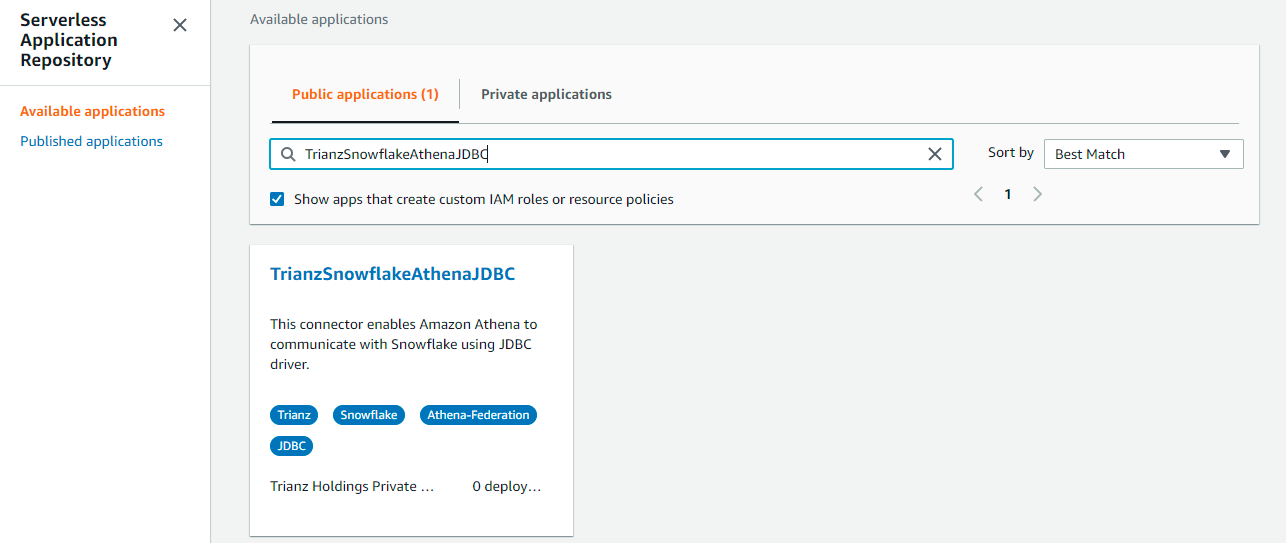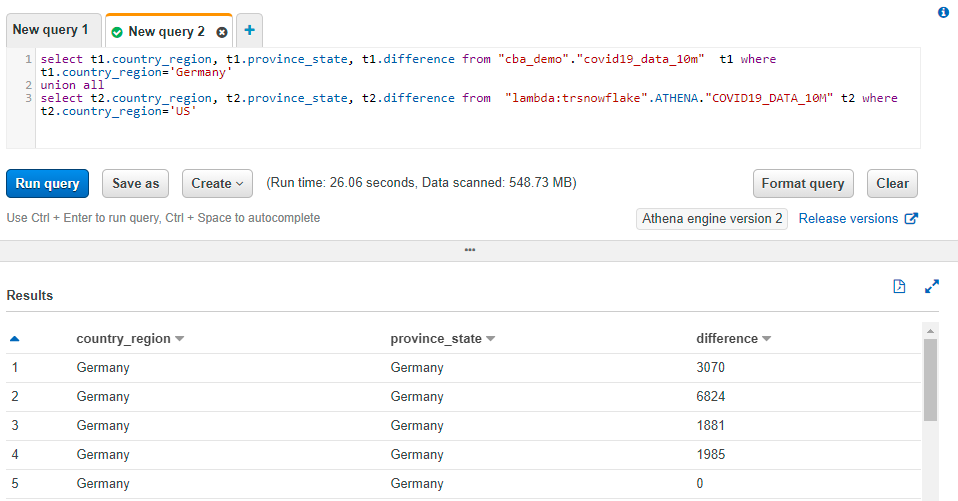Post Syndicated from Navnit Shukla original https://aws.amazon.com/blogs/big-data/query-snowflake-using-athena-federated-query-and-join-with-data-in-your-amazon-s3-data-lake/
If you use data lakes in Amazon Simple Storage Service (Amazon S3) and use Snowflake as your data warehouse solution, you may need to join your data in your data lake with Snowflake. For example, you may want to build a dashboard by joining historical data in your Amazon S3 data lake and the latest data in your Snowflake data warehouse or create consolidated reporting.
In such use cases, Amazon Athena Federated Query allows you to seamlessly access the data from Snowflake without building ETL pipelines to copy or unload the data to the S3 data lake or Snowflake. This removes the overhead of creating additional extract, transform, and load (ETL) processes and shortens the development cycle.
In this post, we will walk you through a step-by-step configuration to set up Athena Federated Query using AWS Lambda to access data in a Snowflake data warehouse.
For this post, we are using the Snowflake connector for Amazon Athena developed by Trianz.
Let’s start with discussing the solution and then detailing the steps involved.
Solution overview
Data Federation refers to the capability to query data in another data store using a single interface (Amazon Athena). The following diagram depicts how a single Amazon Athena federated query uses Lambda to query the underlying data source and parallelizes execution across many workers.
Athena is an interactive query service that makes it easy to analyze data in Amazon S3 using standard SQL. If you have data in sources other than Amazon S3, you can use Athena Federated Query to query the data in place or build pipelines to extract data from multiple data sources and store them in Amazon S3. With Athena Federated Query, you can run SQL queries across data stored in relational, non-relational, object, and custom data sources.
When a federated query is run, Athena identifies the parts of the query that should be routed to the data source connector and executes them with Lambda. The data source connector makes the connection to the source, runs the query, and returns the results to Athena. If the data doesn’t fit into Lambda RAM runtime memory, it spills the data to Amazon S3 and is later accessed by Athena.
Athena uses data source connectors which internally use Lambda to run federated queries. Data source connectors are pre-built and can be deployed from the Athena console or from the Serverless Application Repository. Based on the user submitting the query, connectors can provide or restrict access to specific data elements.
To implement this solution, we complete the following steps:
- Create a secret for the Snowflake instance using AWS Secrets Manager.
- Create an S3 bucket and subfolder for Lambda to use.
- Configure Athena federation with the Snowflake instance.
- Run federated queries with Athena.
Prerequisites
Before getting started, make sure you have a Snowflake data warehouse up and running.
Create a secret for the Snowflake instance
Our first step is to create a secret for the Snowflake instance with a username and password using Secrets Manager.
- On the Secrets Manager console, choose Secrets.
- Choose Store a new secret.
- Select Other types of secrets.
- Enter the credentials as key-value pairs (username, password) for your Snowflake instance.
- For Secret name, enter a name for your secret. Use the prefix
snowflakeso it’s easy to find.
- Leave the remaining fields at their defaults and choose Next.
- Complete your secret creation.
Create an S3 bucket for Lambda
On the Amazon S3 console, create a new S3 bucket and subfolder for Lambda to use. For this post, we use athena-accelerator/snowflake.
Configure Athena federation with the Snowflake instance
To configure Athena data source connector for Snowflake with your Snowflake instance, complete the following steps:
- On the AWS Serverless Application Repository console, choose Available applications.
- In the search field, enter
TrianzSnowflakeAthenaJDBC.
- For Application name, enter
TrianzSnowflakeAthenaJDBC. - For SecretNamePrefix, enter
trianz-snowflake-athena. - For SpillBucket, enter
Athena-accelerator/snowflake. - For JDBCConnectorConfig, use the format
snowflake://jdbc:snowflake://{snowflake_instance_url}/?warehouse={warehousename}&db={databasename}&schema={schemaname}&${secretname}
For example, we enter snowflake://jdbc:snowflake://trianz.snowflakecomputing.com/?warehouse=ATHENA_WH&db=ATHENA_DEV&schema=ATHENA&${trianz-snowflake-athena}DisableSpillEncyption – False
- For LambdaFunctionName, enter
trsnowflake. - For SecurityGroupID, enter the security group ID where the Snowflake instance is deployed.
Make sure to apply valid inbound and outbound rules based on your connection.
- For SpillPrefix, create a folder under the S3 bucket you created and specify the name (for example,
athena-spill). - For Subnetids, use the subnets where the Snowflake instance is running with comma separation.
Make sure the subnet is in a VPC and has NAT gateway and internet gateway attached.
- Select the I acknowledge check box.
- Choose Deploy.
Make sure that the AWS Identity and Access Management (IAM) roles have permissions to access AWS Serverless Application Repository, AWS CloudFormation, Amazon S3, Amazon CloudWatch, AWS CloudTrail, Secrets Manager, Lambda, and Athena. For more information, see Example IAM Permissions Policies to Allow Athena Federated Query.
Run federated queries with Athena
Before running your federated query, be sure that you have selected Athena engine version 2. The current Athena engine version for any workgroup can be found in the Athena console page.
Run your federated queries using lambda:trsnowflake to run against tables in the Snowflake database. This is the name of lambda function which we have created in step 7 of previous section of this blog.
lambda:trsnowflake is a reference data source connector Lambda function using the format lambda:MyLambdaFunctionName. For more information, see Writing Federated Queries.
The following screenshot is a unionall query example of data in Amazon S3 with a table in the AWS Glue Data Catalog and a table in Snowflake.
Key performance best practices
If you’re considering Athena Federated Query with Snowflake, we recommend the following best practices:
- Athena Federated query works great for queries with predicate filtering because the predicates are pushed down to the Snowflake database. Use filter and limited-range scans in your queries to avoid full table scans.
- If your SQL query requires returning a large volume of data from Snowflake to Athena (which could lead to query timeouts or slow performance), you may consider copying data from Snowflake to your S3 data lake.
- The Snowflake schema, which is an extension of the star schema, is used as a data model in Snowflake. In the Snowflake schema model, unload your large fact tables into your S3 data lake and leave the dimension tables in Snowflake. If large dimension tables are contributing to slow performance or query timeouts, unload those tables to your S3 data lake.
- When you run federated queries, Athena spins up multiple Lambda functions, which causes a spike in database connections. It’s important to monitor the Snowflake database WLM queue slots to ensure there is no queuing. Additionally, you can use concurrency scaling on your Snowflake database cluster to benefit from concurrent connections to queue up.
Conclusion
In this post, you learned how to configure and use Athena federated with Snowflake using Lambda. With Athena Federated query user can leverage all of their data to produce analytics, derive business value without building ETL pipelines to bring data from different datastore such as Snowflake to Data Lake.
You can use the best practice considerations outlined in the post to help minimize the data transferred from Snowflake for better performance. When queries are well written for federation, the performance penalties are negligible.
For more information, see the Athena User Guide and Using Amazon Athena Federated Query.
About the Author
 Navnit Shukla is AWS Specialist Solution Architect in Analytics. He is passionate about helping customers uncover insights from their data. He has been building solutions to help organizations make data-driven decisions.
Navnit Shukla is AWS Specialist Solution Architect in Analytics. He is passionate about helping customers uncover insights from their data. He has been building solutions to help organizations make data-driven decisions.





